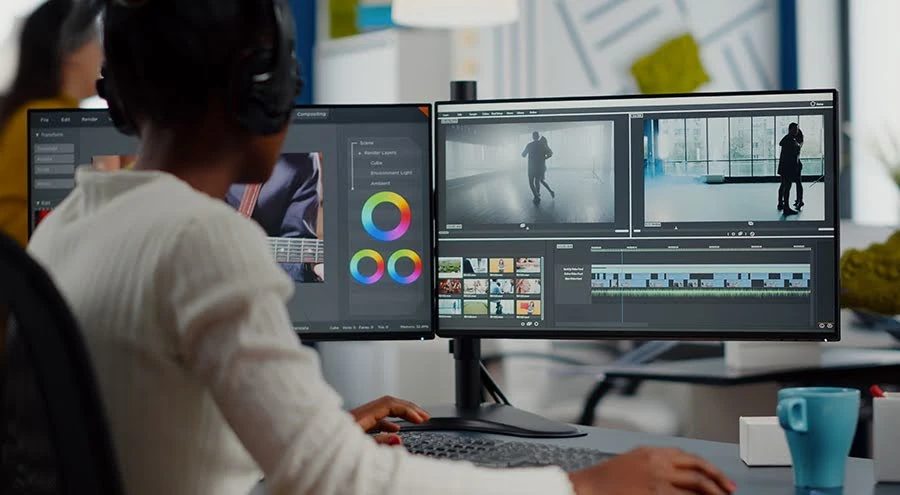
How Media Production Software Can Improve Your Workflow?
The technology-driven world in which we now live designated media production an extremely significant role in content creation for multifarious areas, including business, entertainment, education, and social media. With much more demand for high-quality audiovisual content, these media creators are now more determined to work smartly and efficiently. The rapidly changing outlook of media production software holds promise for professionals and enthusiasts to do their workflows more efficiently, generate more creativity, and communicate better.
What is Media Production Software?
Media production software is the digital tools or applications used in creating, editing, managing, and distributing multimedia content. Some of these tools and applications may include video editing, graphics design, animation, audio, and post-production effects.
Whether you are a filmmaker, content creator, designer, or musician, the media production software helps simplify the process, unleash creativity, and enhance efficiency. Adobe Premiere Pro for video editing, Photoshop for graphic designs, Audition for audio production, and After Effects for motion graphics are examples.
How Media Production Software Improve Workflow
-
Automation and Time-Saving Features
The very prime use of modern media production software is automation. Many such tools have now AI-artificial intelligence features that assist creators in performing fairly repetitive, time-consuming tasks in greater efficiency.
Video editing software like Adobe Premiere Pro, Davinci Resolve, and Final Cut Pro includes such features:
- Auto captioning and subtitles-AI-generated captions save much time while also promoting accessibility.
- Smart color correction – AI-powered color grading adjusts tones automatically.
- Auto-syncing audio and video – Makes separate audio recordings not needing to be manually aligned.
The same goes for background removal, object selection, and automatic layout suggestions in graphic designing by Photoshop and Canva which merely take up editing time. Distributing the editing process with such automation allows media professionals to invest more energy in creative thinking instead of technical adjustments.
-
Seamless Collaboration
Collaborative functions are of the utmost importance in media production, especially for those working from a distance or outside of the same time zone. From a modern perspective, this is facilitated by an array of tools that tend to be cloud-centric so that more than one person can work on a project simultaneously.
Adobe Creative Cloud, Frame.io, and DaVinci Resolve Cloud provide
- Shared workspaces for collaborative editing and project review.
- Version control that keeps track of changes and allows users to revert to any previous edit.
- Annotation tools that allow people to leave comments directly on videos, images, or audio files.
In turn, such uninterrupted collaboration diminishes ambiguity, hastens approvals, and guarantees that everyone is on the same page, thus making the workflow seamless.

-
Improved Organization and Asset Management
When dealing with large numbers of files involved with video, images, sound clips, and other design elements, chaos works best without an organizational matrix in place. This is where Digital Asset Management (DAM) systems come into play.
Media Production Software helps to:
- Assign relevant metadata that makes search and retrieval easier on the files.
- Store and retrieve assets in the cloud, preventing the risk of losing important files.
- Keep track of updates and edits using relevant versioning tools.
Adobe Bridge and Google Drive, for example, help organize huge media libraries, alongside other top-rated film management tools that streamline asset control. If assets are organized and cataloged, there will be a smooth workflow, thus preventing time wasted in searching for misplaced files.
-
Enhanced Editing Capabilities
Modern-day media production software consists of the NLE systems allowing creators to manipulate files at will without altering the original material. Thus, it provides flexibility for producing high-quality productions across creative fields.
For Video Editing:
Software like Premiere Pro, Final Cut Pro, and DaVinci Resolve offers:
- Multi-camera editing
- Advanced color grading
- Motion graphics and VFX integration
For Audio Production:
Software like Adobe Audition and Pro Tools provides:
- Noise reduction and sound restoration for high-quality audio.
- Multitrack mixing for balancing dialogue, music, and effects.
- Equalization and reverb tools for a professional sound.

-
Faster Rendering and Exporting
Both rendering and exporting are pivotal stages in production. Suffice to say, media production software has evolved tremendously and has incorporated support for GPU acceleration and highly optimized rendering engines for processing.
A few examples are:
- DaVinci Resolve is fast in video rendering through GPU enhancement.
- Adobe Media Encoder offers optimized export settings for different platforms.
- FFmpeg enables fast encoding and some compression for various media formats.
Fast rendering allows creators to complete projects on time without sacrificing quality, which is one of the foremost requirements of professional media production.
-
Multi-Platform Integration
Media professionals tend often to use several software tools in a single project. Modern media production software has been designed with seamless integration to provide unhindered workflow among different applications.
Examples are:
- Premiere Pro uses After Effects for motion graphics and Audition for audio editing, all integrated into a single production workflow.
- Final Cut Pro works well with Motion and Logic Pro for video and sound design.
- Blender connects to Unreal Engine for real-time rendering and game development.
There are also plug-ins and APIs for custom implementation that allow the software to be molded into creators’ specific needs, especially when choosing the right production management software for streamlined workflows.
Advantages of Media Production Software
- Increased Efficiency
- High-Quality Output
- Collaboration Friendly
- Better Organization
- Scalability
Supports sustainable practices through green production software
Limitations of Media Production Software
- High Cost
- Steep Learning Curve
- Hardware Requirements
- Subscription Based Pricing
- File Size and Storage Issue
Conclusion
Software for media production could reinvent the creation of content, rendering it really effective, collaborative, and on a high level for postproduction output. Filmmakers, content producers, designers, and sound engineers can ensure better efficiency, time-saving, and creativity within their working environment with well-selected software.
Apart from the great aspect of media production software, one needs to keep important drawbacks into consideration, so he or she could get specific software that fits the need. Going advanced in technology would still require investing in state-of-the-art media production software to keep producing vivacious and even powerful content.
Frequently Asked Questions
What should I consider when choosing media production software?
- Your needs (video editing, graphic design, animation, etc.).
- Ease of use – Beginner-friendly or advanced tools?
- System requirements – Can your computer handle it?
- Collaboration features – Do you need cloud-based sharing?
- Budget – Free or paid options based on your needs.
What file formats are commonly used in media production?
Common file formats include:
- Video: MP4, MOV, AVI, MKV
- Audio: MP3, WAV, FLAC
- Images: JPEG, PNG, TIFF, PSD
- 3D & Animation: OBJ, FBX, GIF
How can I improve my skills in media production software?
Watch tutorials either on YouTube or platforms, such as Udemy and Skillshare.
Develop consistent real projects in which one practices.
Join online communities and forums for tips and feedback.
Take up official certification courses (e.g., Adobe Certified Professional).
Can I use media production software on a mobile device?
Yes, many media production tools have mobile versions,
- Adobe Premiere Rush – Mobile video editing for devices
- Canva – Graphic Design on the go with mobile
- GarageBand – iOS audio production
- KineMaster – Professional video editing for mobile
Mobile applications are great at editing clips quickly, but desktop applications have very powerful features.

